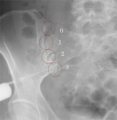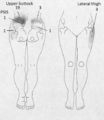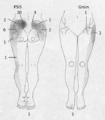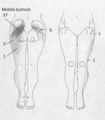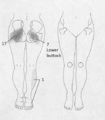◔
Sacroiliac Pain Maps: Difference between revisions
From WikiMSK
No edit summary |
No edit summary |
||
| Line 12: | Line 12: | ||
File:aizawa section 3.png|Section 3 map | File:aizawa section 3.png|Section 3 map | ||
</gallery> | </gallery> | ||
<small>Images Copyright © 2020 Springer Nature Switzerland AG</small> | |||
==References== | ==References== | ||
Revision as of 19:18, 1 September 2020
This article is a stub.
Sacroiliac Joint Pain can have a variable distribution. Buttock, PSIS pain is present in 94%, lower lumbar pain in 72%, groin pain in 14%, lower extremity pain in 28%, upper lumbar in 6%, abdomen in 2%, and foot in 12%. [1]
Sacroiliac Posterior Ligament Pain
The pain pattern from sacroiliac ligaments depends on which ligamentous section is involved. Patients in this study were diagnosed with sacroiliac joint dysfunction with a fluoroscopically guided periarticular SIJ injection with a >70% relief of pain. [2] This built on their previous work.[3]
Images Copyright © 2020 Springer Nature Switzerland AG
References
- ↑ Vanelderen et al.. 13. Sacroiliac joint pain. Pain practice : the official journal of World Institute of Pain 2010. 10:470-8. PMID: 20667026. DOI.
- ↑ Kurosawa et al.. Referred pain location depends on the affected section of the sacroiliac joint. European spine journal : official publication of the European Spine Society, the European Spinal Deformity Society, and the European Section of the Cervical Spine Research Society 2015. 24:521-7. PMID: 25283251. DOI.
- ↑ Murakami et al.. Effect of periarticular and intraarticular lidocaine injections for sacroiliac joint pain: prospective comparative study. Journal of orthopaedic science : official journal of the Japanese Orthopaedic Association 2007. 12:274-80. PMID: 17530380. DOI.
